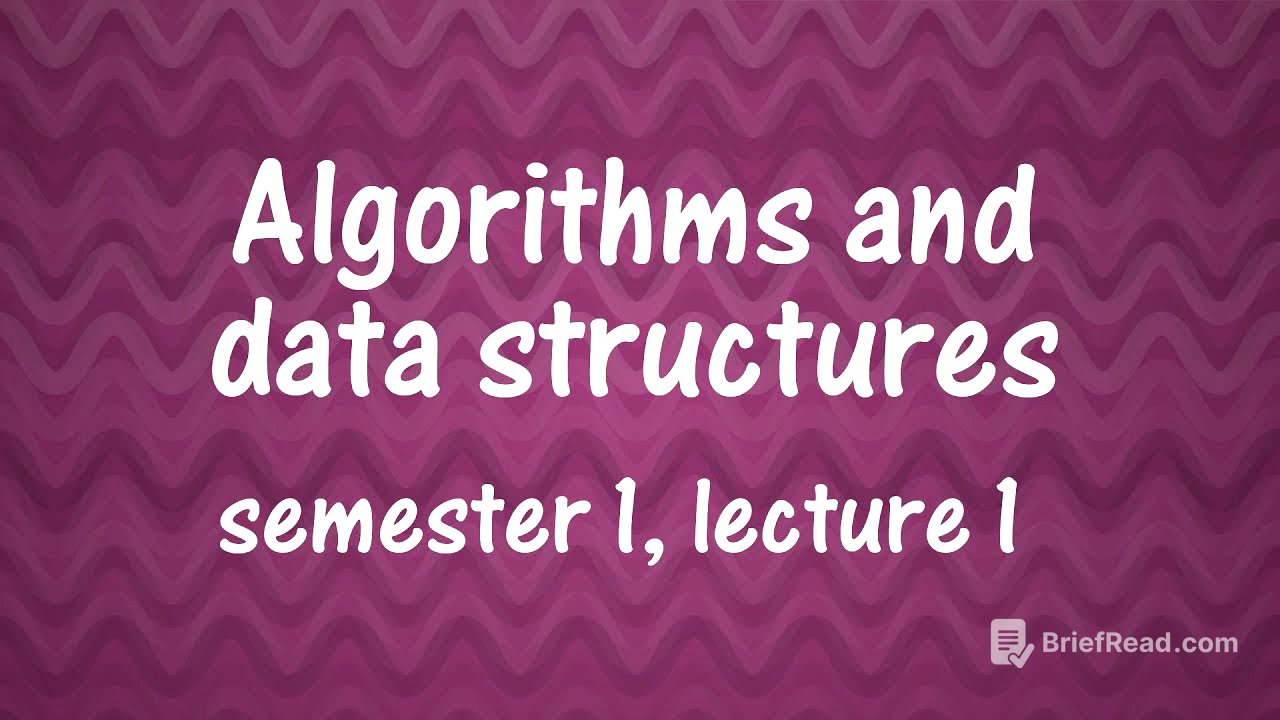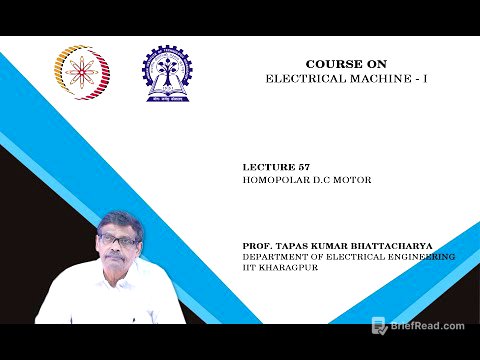TLDR;
This lecture introduces fundamental concepts in algorithms and data structures, contrasting it with competitive programming-focused courses. It covers the definition of an algorithm, methods for measuring efficiency (time complexity), and the Big O notation for expressing algorithm performance. The lecture also discusses computational models like the RAM model, and analyzes the time complexity of basic algorithms like summing array elements and sorting algorithms such as insertion sort and merge sort. Finally, it touches on the Master Theorem for analyzing divide and conquer algorithms.
- Definition of an algorithm and its role in solving problems.
- Time complexity measurement using the number of operations rather than seconds.
- Introduction to the RAM model as a computational model.
- Big O, Big Omega, and Big Theta notations for expressing algorithm complexity.
- Analysis of sorting algorithms: insertion sort and merge sort.
- Introduction to the Master Theorem for divide and conquer algorithms.
Introduction to the Course [0:08]
The course is designed to explore the theoretical aspects of algorithms and data structures, distinguishing itself from competitive programming-focused courses available on platforms like Codeforces. Unlike the practical, trick-oriented approach of competitive programming, this course mirrors a more fundamental, theoretical curriculum similar to that of an ITMO course. The course spans four semesters, offering a long-term, in-depth study of the subject matter. Lectures are planned for every Friday, with a Google Calendar link provided for schedule adjustments. While practice tasks are intended, their format, whether contests or theoretical problems, remains to be determined.
What is an Algorithm? [2:57]
An algorithm is defined as a formalized method for solving a problem, breaking down the solution into a series of elementary steps or simple operations. Algorithms are widely applicable across various disciplines, but this course primarily focuses on data processing algorithms. These algorithms typically involve loading input data, processing it, and producing output data, similar to the structure of problems encountered in competitive programming. A simple example is calculating the sum of numbers in an array, which can be expressed through pseudocode involving initializing a sum variable, iterating through array elements, and adding each element to the sum.
Time Complexity [7:20]
Time complexity is a key characteristic used to evaluate the efficiency of an algorithm, representing the time spent by the algorithm to solve a problem. Instead of measuring time in seconds, which varies across different computers, time complexity is measured by counting the number of operations. This approach requires defining a computational model, such as the RAM model, which abstracts the computer's hardware to provide a consistent environment for analyzing algorithms. The RAM model simulates a typical computer processor with memory that can be accessed in constant time, along with standard arithmetic and logical operations.
Computational Model: RAM Model [11:50]
The RAM (Random Access Memory) model is a fundamental computational model that simulates a computer's processor. It features memory as a large array where each cell can be accessed in constant time using its address. This model allows for direct access to any memory element in a single operation, which is a key aspect of its design. In addition to memory operations, the RAM model includes standard arithmetic operations, cycles, and conditional statements, mirroring the capabilities of typical programming languages.
Calculating Time Complexity [15:14]
The time complexity of an algorithm depends on the input size, with larger inputs generally requiring more operations. For an array of size n, the time complexity can be expressed as a function of n. For example, summing the elements of an array involves initializing a sum variable, iterating through the array, and adding each element to the sum. The total number of operations can be represented as 1 + 2 + 5n, where 1 is for initialization, 2 is for loop overhead, and 5n is for the addition and memory access within the loop.
Big O Notation [18:09]
Big O notation is used to simplify the expression of time complexity by removing unimportant details and focusing on the dominant terms. For example, in the expression 2 + 5n, the constant 2 and the constant factor 5 are not as significant as the linear term n, especially as n grows large. Big O notation provides an upper bound on the growth rate of an algorithm's time complexity. Formally, f(n) is O(g(n)) if there exist constants n0 and c such that for all n >= n0, f(n) <= c * g(n).
Big Omega and Big Theta Notations [27:14]
Big O notation provides an upper bound on the complexity of an algorithm, while Big Omega (Ω) notation provides a lower bound. Big Omega is defined such that there exist constants n0 and c for which f(n) >= c * g(n) for all n >= n0. When an algorithm has both an upper bound (Big O) and a lower bound (Big Omega) that are the same, it can be described using Big Theta (Θ) notation, indicating a tight bound on the algorithm's complexity. In practical algorithm design, proving the upper bound is often more critical as it demonstrates that the algorithm is fast enough.
Calculating Number of Operations [33:36]
Calculating the number of operations for an algorithm varies in complexity depending on the algorithm's structure. For simple for loops, the calculation is straightforward. For nested loops, the number of operations is the product of the iterations of each loop. When dealing with while loops, it is important to identify how the loop's variables change with each iteration to determine the total number of iterations. For example, a loop that increments a variable until its square exceeds n has a time complexity of O(√n).
Recursive Algorithms [40:09]
Recursive algorithms involve functions that call themselves, and their time complexity is determined by the number of recursive calls and the work done in each call. For a function that calls itself n times, the time complexity is O(n). When a function makes multiple recursive calls, such as two calls with input size n/2, the time complexity can be more complex, potentially leading to a tree of recursive calls. The total number of operations then depends on the number of nodes in this tree and the work done at each node.
Sorting Algorithms: Insertion Sort [54:00]
Sorting algorithms arrange elements of an array in a specific order. Insertion sort works by iterating through the array and inserting each element into its correct position within the already sorted portion of the array. The algorithm maintains a sorted prefix and extends it by moving elements to the left until they are in the correct order. The time complexity of insertion sort varies depending on the input. In the best case, when the array is already sorted, the time complexity is O(n). In the worst case, when the array is in reverse order, the time complexity is O(n^2).
Sorting Algorithms: Merge Sort [1:03:50]
Merge sort is a sorting algorithm that uses a divide and conquer approach. The central operation in merge sort is the merge procedure, which combines two sorted arrays into a single sorted array. This is done by comparing the first elements of each array and moving the smaller element to the merged array, repeating until all elements are merged. The merge operation has a time complexity of O(n + m), where n and m are the sizes of the input arrays. Merge sort recursively divides the array into halves, sorts each half, and then merges the sorted halves.
Time Complexity of Merge Sort [1:21:45]
The time complexity of merge sort is O(n log n). This is because the algorithm divides the array into two halves at each step, resulting in a logarithmic number of levels. At each level, the merge operation takes linear time, O(n). Therefore, the total time complexity is the product of the number of levels and the time per level, which is O(n log n). This can be proven by mathematical induction, showing that the time complexity is no more than c * n log n for some constant c.
Master Theorem [1:29:39]
The Master Theorem provides a general solution for the time complexity of divide and conquer algorithms. It applies to algorithms that divide the input into b chunks, make a recursive calls, and spend additional time f(n) to combine the results. The theorem states that if f(n) is much less than n^(log_b a), then the time complexity is O(n^(log_b a)). If f(n) is much greater than n^(log_b a), then the time complexity is O(f(n)). If f(n) is the same as n^(log_b a), then the time complexity is O(n^(log_b a) * log n).









